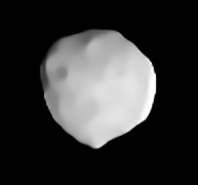324 Bamberga
324 Bamberga is the 16th biggest asteroid in the Main asteroid belt. It was found by Johann Palisa on February 25, 1892 in Vienna, making it one of the last big (diameter over 200 km) asteroids found. Apart from the near-earth asteroid Eros, it was the last asteroid which is ever easily visible with binoculars to be found.
 VLT image of Bamberga | |
| Discovery | |
|---|---|
| Discovered by | Johann Palisa |
| Discovery date | 25 February 1892 |
| Designations | |
| MPC designation | (324) Bamberga |
| Pronunciation | /bæmˈbɜːrɡə/ bam-BUR-gə |
Named after | Bamberg |
| Main belt | |
| Orbital characteristics[1] | |
| Epoch 31 July 2016 (JD 2457600.5) | |
| Uncertainty parameter 0 | |
| Observation arc | 124.08 yr (45321 d) |
| Aphelion | 3.59442 AU (537.718 Gm) |
| Perihelion | 1.77023 AU (264.823 Gm) |
| 2.68232 AU (401.269 Gm) | |
| Eccentricity | 0.34004 |
| 4.39 yr (1604.6 d) | |
| 225.419° | |
| 0° 13m 27.682s / day | |
| Inclination | 11.1011° |
| 327.883° | |
| 44.2409° | |
| Physical characteristics | |
| Dimensions | 229.44±7.4 km[1] 234.67 ± 7.80 km 229.4 ± 7.4 km (IRAS)[2] |
| Mass | 1.1×1019 kg[3] (1.03 ± 0.10) × 1019 kg |
Mean density | 1.52 ± 0.20 g/cm3 |
| 1.226 d[4] 29.43 h (1.226 d)[1] | |
| 0.0628±0.004[1] 0.0628[2] | |
| C-type asteroid[5] | |
| 6.82[1][2] | |
Although its very high orbital eccentricity means its opposition magnitude varies a lot, at a rare opposition near perihelion Bamberga can reach a magnitude of +8.0,[6] which is as bright as Saturn's moon Titan. Such near-perihelion oppositions happen on a regular cycle every twenty-two years, with the last happening in 1991 and the next in 2013. Its brightness at these rare near-perihelion oppositions makes Bamberga the brightest C-type asteroid, about one magnitude brighter than 10 Hygiea's maximum brightness of around +9.1. At such an opposition Bamberga can in fact be closer to Earth than any main belt asteroid with magnitude above +9.5, getting as close as 0.78 AU. For comparison, 7 Iris never comes closer than 0.85 AU and 4 Vesta never closer than 1.13 AU when it becomes visible to the naked eye in a pollution-free sky.
Overall Bamberga is the tenth brightest main belt asteroid after, in order, Vesta, Pallas, Ceres, Iris, Hebe, Juno, Melpomene, Eunomia and Flora. Its high eccentricity (for comparison 36% higher than that of Pluto), though, means that at most oppositions other asteroids reach higher magnitudes.
It has an unusually long rotation period among the big asteroids. Its spectral class is between the C-type and P-type asteroids.[5]
An occultation of Bamberga was seen on 8 December, 1987, and gave a diameter of about 228 km, in agreement with IRAS results.
324 Bamberga Media
References
- ↑ 1.0 1.1 1.2 1.3 1.4 "JPL Small-Body Database Browser: 324 Bamberga". 2008-07-26 last obs. Retrieved 11 May 2016.
- ↑ 2.0 2.1 2.2 Tedesco, E.F.; Noah, P.V.; Noah, M.; Price, S.D. (2004). "IRAS Minor Planet Survey. IRAS-A-FPA-3-RDR-IMPS-V6.0". NASA Planetary Data System. Archived from the original on January 17, 2010. Retrieved 2007-03-15.
- ↑ Pitjeva, E. V. (2005). "High-Precision Ephemerides of Planets—EPM and Determination of Some Astronomical Constants" (PDF). Solar System Research. 39 (3): 176–186. Bibcode:2005SoSyR..39..176P. doi:10.1007/s11208-005-0033-2. S2CID 120467483. Archived from the original (PDF) on 2008-10-31.
- ↑ Harris, A. W.; Warner, B.D.; Pravec, P., eds. (2006). "Asteroid Lightcurve Derived Data. EAR-A-5-DDR-DERIVED-LIGHTCURVE-V8.0". NASA Planetary Data System. Archived from the original on 2007-01-28. Retrieved 2007-03-15.
- ↑ 5.0 5.1 Neese, C., ed. (2005). "Asteroid Taxonomy.EAR-A-5-DDR-TAXONOMY-V5.0". NASA Planetary Data System. Archived from the original on 2007-03-10. Retrieved 2007-03-15.
- ↑ Donald H. Menzel and Jay M. Pasachoff (1983). A Field Guide to the Stars and Planets (2nd. ed.). Boston, MA: Houghton Mifflin. p. 391. ISBN 0-395-34835-8.
